Phenolic Composition and Bioactivities of Invasive Ailanthus altissima (Mill.) Swingle Leaf Extracts Obtained by Two-Step Sequential Extraction
Abstract
1. Introduction
2. Materials and Methods
2.1. Plant Material and Chemical Reagents
2.2. Characterization of Fresh and Dried Leaves of A. altissima by SEM and Color Variations
2.2.1. SEM Analysis
2.2.2. Color Measurements
2.3. Preparation of Polar and Non-Polar Extracts
- Extraction solvents: 70% ethanol was used as polar solvent and n-hexane as non-polar solvent;
- Solid/solvent ratio (w/v): 1/10;
- Extraction temperature by maceration: r.t.;
- Extraction time by maceration: 12 h in dark. Material was soaked in solvent under magnetic stirring (Magnetic stirring rod IKA RO10) at 800 rpm for 3 h, after which the material was stirred occasionally for 3 h, and then left without stirring for 6 h.
2.4. Content of Phenolics and Carotenoids
2.5. Antioxidant Activity
2.5.1. Ferric Reducing Antioxidant Power (FRAP)
2.5.2. Radical Scavenging Activity (RSA) Using the 1, 1-diphenyl-2-picryl-hydrazyl (DPPH) Assay
2.6. Antimicrobial Activity
2.7. Statistical Analysis
3. Results and Discussion
3.1. Microstructural Properties of Fresh and Dried Leaves by SEM
3.2. Color Changes in Leaf Samples Undergoing Drying
3.3. The Influence of Harvesting Season, Processing, and Two-Step Sequential Extraction on the Total Content of Bioactive Compounds in A. altissima Leaves
3.4. Antioxidant Activity
3.5. Antimicrobial Activity
4. Conclusions
Author Contributions
Funding
Institutional Review Board Statement
Informed Consent Statement
Data Availability Statement
Conflicts of Interest
References
- Arun, M.N.; Kumar, R.M.; Sreedevi, B.; Padmavathi, G.; Revathi, P.; Pathak, N.; Srinivas, D.; Venkatanna, B. The rising threat of invasive alien plant species in agriculture. In Resource Management in Agroecosystems; Ondrasek, G., Zhang, L., Eds.; IntechOpen Limited: London, UK, 2022. [Google Scholar] [CrossRef]
- Cocîrlea, M.D.; Oancea, S. Impact of invasive plant species on ecosystems, biodiversity loss and their potential industrial applications. Curr. Trends Nat. Sci. 2022, 11, 88–103. [Google Scholar] [CrossRef]
- Demeter, A.; Saláta, D.; Tormáné Kovács, E.; Szirmai, O.; Trenyik, P.; Meinhardt, S.; Rusvai, K.; Neumann, K.V.; Schermann, B.; Szegleti, Z.; et al. Effects of the invasive tree species Ailanthus altissima on the floral diversity and soil properties in the Pannonian Region. Land 2021, 10, 1155. [Google Scholar] [CrossRef]
- Motti, R.; Zotti, M.; Bonanomi, G.; Cozzolino, A.; Stinca, A.; Migliozzi, A. Climatic and anthropogenic factors affect Ailanthus altissima invasion in a Mediterranean region. Plant Ecol. 2021, 222, 1347–1359. [Google Scholar] [CrossRef]
- Sîrbu, C.; Anastasiu, P.; Urziceanu, M.; Camen-Comănescu, P.; Sîrbu, I.M.; Popa, A.M.; Ioja, C.; Gavrilidis, A.A.; Oprea, A. Invasive alien plant species in Romania of European Union concern. Environ. Socio-Econ. Stud. 2021, 9, 32–44. [Google Scholar] [CrossRef]
- Luís, Â.; Gil, N.; Amaral, M.E.; Domingues, F.; Duartea, A.P. Ailanthus altissima (Miller) Swingle: A source of bioactive compounds with antioxidant activity. BioResources 2012, 7, 2105–2120. [Google Scholar] [CrossRef]
- Wang, R.X.; Mao, X.X.; Zhou, J.; Zhang, M.L.; Wu, Y.B.; Huo, C.H.; Shi, Q.W.; Sauriol, F.; Gu, Y.C. Antitumor activities of six quassinoids from Ailanthus altissima. Chem. Nat. Compd. 2017, 53, 28–32. [Google Scholar] [CrossRef]
- Li, X.; Li, Y.; Ma, S.; Zhao, Q.; Wu, J.; Duan, L.; Xie, I.; Wang, S. Traditional uses, phytochemistry, and pharmacology of Ailanthus altissima (Mill.) Swingle bark: A comprehensive review. J. Ethnopharmacol. 2021, 275, 114121. [Google Scholar] [CrossRef]
- Caramelo, D.; Pedro, S.I.; Marques, H.; Simão, A.Y.; Rosado, T.; Barroca, C.; Gominho, J.; Anjos, O.; Gallardo, E. Insights into the bioactivities and chemical analysis of Ailanthus altissima (Mill.) Swingle. Appl. Sci. 2021, 11, 11331. [Google Scholar] [CrossRef]
- Huo, Q.; Shao, J.; Lin, Q. Study on the antibacterial and bactericidal effects of Ailanthus altissima leaves extract. Asian J. Chem. 2012, 24, 3545. [Google Scholar]
- Poljuha, D.; Sladonja, B.; Šola, I.; Dudaš, S.; Bilić, J.; Rusak, G.; Motlhatlego, K.E.; Eloff, J.N. Phenolic composition of leaf extracts of Ailanthus altissima (Simaroubaceae) with antibacterial and antifungal activity equivalent to standard antibiotics. Nat. Prod. Commun. 2017, 12, 1609–1612. [Google Scholar]
- Rahman, H.M.A.; Javaid, S.; Ashraf, W.; Rasool, M.F.; Saleem, H.; Khan, S.A.; Ul-Haq, Z.; Anjum, S.M.M.; Ahmad, T.; Alqahtani, F.; et al. Effects of long-term Ailanthus altissima extract supplementation on fear, cognition and brain antioxidant levels. Saudi. Pharm. J. 2023, 31, 191–206. [Google Scholar] [CrossRef]
- Daga, M.; Pizzimenti, S.; Dianzani, C.; Cucci, M.A.; Cavalli, R.; Grattarola, M.; Ferrara, B.; Scariot, V.; Trotta, F.; Barrera, G. Ailanthone inhibits cell growth and migration of cisplatin resistant bladder cancer cells through down-regulation of Nrf2, YAP, and c-Myc expression. Phytomedicine 2019, 56, 156–164. [Google Scholar] [CrossRef] [PubMed]
- Wang, C.M.; Li, H.F.; Wang, X.K.; Li, W.G.; Su, Q.; Xiao, X.; Hao, T.F.; Chen, W.; Zhang, Y.W.; Zhang, H.Y.; et al. Ailanthus altissima-derived ailanthone enhances gastric cancer cell apoptosis by inducing the repression of base excision repair by downregulating p23 expression. Int. J. Biol. Sci. 2021, 17, 2811. [Google Scholar] [CrossRef]
- Andonova, T.; Muhovski, Y.; Slavov, I.; Vrancheva, R.; Georgiev, V.; Apostolova, E.; Naimov, S.; Mladenov, R.; Pavlov, A.; Dimitrova-Dyulgerova, I. Phenolic profile, antioxidant and DNA-protective capacity, and microscopic characters of Ailanthus altissima aerial substances. Plants 2023, 12, 920. [Google Scholar] [CrossRef]
- Mohamed, H.R.; El-Wakil, E.A.; Abdel-Hameed, E.S.S.; El-Hashash, M.M.; Shemis, M. Evaluation of total phenolics, flavonoids, and antioxidant and cytotoxic potential of Ailanthus altissima (Mill.) Swingle leaves. J. Rep. Pharm. Sci. 2021, 10, 130–136. [Google Scholar] [CrossRef]
- Mo, Y.N.; Cheng, F.; Yang, Z.; Shang, X.F.; Liang, J.P.; Shang, R.F.; Hao, B.C.; Wang, X.H.; Zhang, H.J.; Wali, A.; et al. Antioxidant activity and the potential mechanism of the fruit from Ailanthus altissima Swingle. Front. Vet. Sci. 2021, 8, 784898. [Google Scholar] [CrossRef]
- Zhelev, I.; Georgiev, K.; Dimitrova-Dyulgerova, I. Carotenoid profile of Ailanthus altissima stem bark, in-vitro antioxidant and antineoplastic activities. Word J. Pharm. Res 2016, 5, 53–60. [Google Scholar]
- Aissani, N.; Jabri, M.A.; Mabrouk, M.; Sebai, H. Antioxidant potential and antimicrobial activity of Ailanthus altissima (Mill.) Swingle extracts against Pseudomonas aeruginosa. J. Mol. Biol. Biotech. 2018, 3, 1–7. [Google Scholar]
- Trošt Sedej, T.; Humar, M.; Gaberščik, A. Cohabiting native Fraxinus ornus and alien Ailanthus altissima differ in their ecophysiological responses and functional traits. Trees 2021, 35, 1875–1887. [Google Scholar] [CrossRef]
- Majd, A.; Rezanejad, F.; Irian, S.; Mousavi, F. Hypersensitivity to Ailanthus altissima (tree of heaven) pollen: Identification of a major IgE-binding component. Aerobiologia 2013, 29, 407–412. [Google Scholar] [CrossRef]
- Knüsel, S.; Conedera, M.; Rigling, A.; Fonti, P.; Wunder, J. A tree-ring perspective on the invasion of Ailanthus altissima in protection forests. For. Ecol. Manag. 2015, 354, 334–343. [Google Scholar] [CrossRef]
- He, Q.; Xiao, H.; Li, J.; Liu, Y.; Jia, M.; Wang, F.; Zhang, Y.; Wang, W.; Wang, S. Fingerprint analysis and pharmacological evaluation of Ailanthus altissima. Int. J. Mol. Med. 2018, 41, 3024–3032. [Google Scholar] [CrossRef]
- Kundu, P.; Laskar, S. A brief resume on the genus Ailanthus: Chemical and pharmacological aspects. Phytochem. Rev. 2010, 9, 379–412. [Google Scholar] [CrossRef]
- Zhang, D.D.; Bai, M.; Yan, Z.Y.; Huang, X.X.; Song, S.J. Chemical constituents from Ailanthus altissima (Mill.) Swingle and chemotaxonomic significance. Biochem. Syst. Ecol. 2020, 93, 104174. [Google Scholar] [CrossRef]
- Am, A.E.B.; Darwish, F.M.; Gouda, Y.G. Phenolic compounds from Ailanthus altissima Swingle. Bull. Pharm. Sci. Assiut Univ. 2000, 23, 111–116. [Google Scholar]
- Albouchi, F.; Hassen, I.; Casabianca, H.; Hosni, K. Phytochemicals, antioxidant, antimicrobial and phytotoxic activities of Ailanthus altissima (Mill.) Swingle leaves. S. Afr. J. Bot. 2013, 87, 164–174. [Google Scholar] [CrossRef]
- Bashir, A.; Farooq, S.; Bhat, Z.A. Pharmacognostic standardization and phytochemical evaluation of Ailanthus altissima (Mill.) Swingle leaves. J. Drug Deliv. Ther. 2019, 9, 179–183. [Google Scholar] [CrossRef]
- Boukhibar, H.; Laouani, A.; Touzout, S.N.; Alenazy, R.; Alqasmi, M.; Bokhari, Y.; Saguem, K.; Ben-Attia, M.; El-Bok, S.; Merghni, A. Chemical composition of Ailanthus altissima (Mill.) Swingle methanolic leaf extracts and assessment of their antibacterial activity through oxidative stress induction. Antibiotics 2023, 12, 1253. [Google Scholar] [CrossRef]
- Souleles, C.; Kokkalou, E. A new β-carboline alkaloid from Ailanthus altissima. Planta Med. 1989, 55, 286–287. [Google Scholar] [CrossRef]
- Guo, S.S.; Duan, Z.K.; Huang, X.X.; Song, S.J. Phytochemical investigation on the leaves of Ailanthus altissima (Mill.) Swingle. Biochem. Syst. Ecol. 2023, 110, 104668. [Google Scholar] [CrossRef]
- Kožuharova, E.; Lebanova, H.; Getov, I.; Benbassat, N.; Kochmarov, V. Ailanthus altissima (Mill.) Swingle-a terrible invasive pest in Bulgaria or potential useful medicinal plant. Bothalia J. 2014, 44, 213–230. [Google Scholar]
- Shin, Y.; Masami, I.; Takakiko, T.; Takahashi, T.; Matsushita, K. Constituents of Ailanthus altissima Swingle. Isolation and structures of shinjuglycosides A, B, C, and D. Bull. Chem. Soc. Jpn. 1984, 57, 2496–2501. [Google Scholar]
- Zhao, C.C.; Shao, J.H.; Li, X.; Xu, J.; Zhang, P. Antimicrobial constituents from fruits of Ailanthus altissima Swingle. Arch. Pharm. Res. 2005, 28, 1147–1151. [Google Scholar] [CrossRef]
- Ansari, S.H.; Ali, M. Two new phytosterols from Ailanthus altissima (Mill) Swingle. Acta Hort. 2003, 597, 91–94. [Google Scholar] [CrossRef]
- Ni, J.C.; Shi, J.T.; Tan, Q.W.; Chen, Q.J. Phenylpropionamides, piperidine, and phenolic derivatives from the fruit of Ailanthus altissima. Molecules 2017, 22, 2107. [Google Scholar] [CrossRef]
- Kuhnert, N. Polyphenole: Vielseitige Pflanzeninhaltsstoffe: In Garten, Industrie, Medizin und Nahrung. Chem. Unserer Zeit 2013, 47, 80–91. [Google Scholar] [CrossRef]
- Caser, M.; Demasi, S.; Caldera, F.; Dhakar, N.K.; Trotta, F.; Scariot, V. Activity of Ailanthus altissima (Mill.) Swingle extract as a potential bioherbicide for sustainable weed management in horticulture. Agronomy 2020, 10, 965. [Google Scholar] [CrossRef]
- Rahman, H.M.A.; Rasool, M.F.; Imran, I. Pharmacological studies pertaining to smooth muscle relaxant, platelet aggregation inhibitory and hypotensive effects of Ailanthus altissima. Evid.-Based Complement. Altern. Med. 2019, 2019, 1871696. [Google Scholar] [CrossRef]
- Anfossi, L.; Giovannoli, C.; Di Nardo, F.; Cavalera, S.; Chiarello, M.; Trotta, F.; Baggiani, C. Selective enrichment of ailanthone from leaves of Ailanthus altissima by tandem reverse phase/molecularly imprinted solid phase extraction. Microchem. J. 2020, 158, 105198. [Google Scholar] [CrossRef]
- Gürbüz, R.; Kahramanoğlu, İ. Possibility of using leaf extracts of tree-of-heaven (Ailanthus altissima (Mill.) Swingle) for the postharvest quality preservation of fresh apricot fruits. Physiol. Mol. Plant Pathol. 2021, 113, 101594. [Google Scholar] [CrossRef]
- Pandey, K.B.; Rizvi, S.I. Plant polyphenols as dietary antioxidants in human health and disease. Oxid. Med. Cell. Longev. 2009, 2, 270–278. [Google Scholar] [CrossRef]
- Cravotto, C.; Fabiano-Tixier, A.S.; Claux, O.; Abert-Vian, M.; Tabasso, S.; Cravotto, G.; Chemat, F. Towards substitution of hexane as extraction solvent of food products and ingredients with no regrets. Foods 2022, 11, 3412. [Google Scholar] [CrossRef]
- Directive 2009/32/EC of the European Parliament and of the Council of 23 April 2009 on the Approximation of the Laws of the Member States on Extraction Solvents Used in the Production of Foodstuffs and Food Ingredients (Recast) (Text with EEA Relevance). 2009, Volume 141, pp. 5–11. Available online: http://data.europa.eu/eli/dir/2009/32/oj/eng (accessed on 23 January 2024).
- US Food and Drug Administration. Q3C-Tables and List Guidance for Industry; US Food and Drug Administration: Silver Spring, MD, USA, 2017. Available online: https://www.fda.gov/media/71737/download (accessed on 22 January 2024).
- Yeasmen, N.; Orsat, V. Phenolic mapping and associated antioxidant activities through the annual growth cycle of sugar maple leaves. Food Chem. 2023, 428, 136882. [Google Scholar] [CrossRef]
- QGIS Development Team QGIS Geographic Information System. Open Source Geospatial Foundation Project 2013. Available online: http://qgis.osgeo.org (accessed on 20 July 2023).
- Qudsieh, H.Y.M.; Yusof, S.; Osman, A.; Rahman, R.A. Effect of maturity on chlorophyll, tannin, color, and polyphenol oxidase (PPO) activity of sugarcane juice (Saccharum officinarum Var. Yellow Cane). J. Agric. Food Chem. 2002, 50, 1615–1618. [Google Scholar] [CrossRef]
- Singleton, V.L.; Rossi, J.A. Colorimetry of total phenolics with phosphomolybdic-phosphotungstic acid reagents. Am. J. Enol. Vitic. 1965, 16, 144–158. [Google Scholar] [CrossRef]
- Cocîrlea, M.D.; Simionescu, N.; Petrovici, A.R.; Silion, M.; Biondi, B.; Lastella, L.; Oancea, S. In vitro screening of ecotoxic and cytotoxic activities of Ailanthus altissima leaf extract against target and non-target plant and animal cells. Int. J. Mol. Sci. 2024, 25, 5653. [Google Scholar] [CrossRef]
- Kumar, S.; Kumar, D.; Saroha, K.; Singh, N.; Vashishta, B. Antioxidant and free radical scavenging potential of Citrullus colocynthis (L.) Schrad. methanolic fruit extract. Acta Pharm. 2008, 58, 215–220. [Google Scholar] [CrossRef]
- Price, M.L.; Van Scoyoc, S.; Butler, L.G. A critical evaluation of the vanillin reaction as an assay for tannin in sorghum grain. Agric. Food Chem. 1978, 26, 1214–1218. [Google Scholar] [CrossRef]
- Scott, K.J. Detection and measurement of carotenoids by UV/VIS spectrophotometry. Curr. Protoc. Food Anal. Chem. 2001, 1, F2.2.1–F2.2.10. [Google Scholar] [CrossRef]
- Benzie, I.F.; Strain, J.J. The ferric reducing ability of plasma (FRAP) as a measure of “antioxidant power”: The FRAP assay. Anal. Biochem. 1996, 239, 70–76. [Google Scholar] [CrossRef]
- Brand-Williams, W.; Cuvelier, M.E.; Berset, C.L.W.T. Use of a free radical method to evaluate antioxidant activity. LWT-Food Sci. Technol. 1995, 28, 25–30. [Google Scholar] [CrossRef]
- Majhenič, L.; Škerget, M.; Knez, Z. Antioxidant and antimicrobial activity of guarana seed extracts. Food Chem. 2007, 104, 1258–1268. [Google Scholar] [CrossRef]
- Bauer, A.W.; Kirby, W.M.M.; Sherris, J.C.; Turck, M. Antibiotic susceptibility testing by a standardized single disk method. Am. J. Clin. Pathol. 1966, 45, 493–496. [Google Scholar] [CrossRef]
- R Core Development Team. R: A Language and Environment for Statistical Computing; Version 4.3.1; R Foundation for Statistical Computing: Vienna, Austria, 2023; Available online: http://www.r-project.org (accessed on 30 September 2023).
- Kassambara, A. ggpubr: ‘ggplot2’ Based Publication Ready Plots, version 0.6.0; R Foundation for Statistical Computing: Vienna, Austria, 2023; Available online: https://CRAN.R-project.org/package=ggpubr (accessed on 13 December 2023).
- Wei, T.; Simko, V. R Package ‘Corrplot’: Visualization of a Correlation Matrix; Version 0.92; R Foundation for Statistical Computing: Vienna, Austria, 2021; Available online: https://github.com/taiyun/corrplot (accessed on 13 December 2023).
- Harrell, F., Jr. Hmisc: Harrell Miscellaneous; Version 5.1-0; R Foundation for Statistical Computing: Vienna, Austria, 2023; Available online: https://CRAN.R-project.org/package=Hmisc (accessed on 13 December 2023).
- Talbot, M.J.; White, R.G. Cell surface and cell outline imaging in plant tissues using the backscattered electron detector in a variable pressure scanning electron microscope. Plant Methods 2013, 9, 40. [Google Scholar] [CrossRef]
- Kröber, W.; Heklau, H.; Bruelheide, H. Leaf morphology of 40 evergreen and deciduous broadleaved subtropical tree species and relationships to functional ecophysiological traits. Plant Biol. 2015, 17, 373–383. [Google Scholar] [CrossRef]
- Yang, X.H.; Deng, L.Z.; Mujumdar, A.S.; Xiao, H.W.; Zhang, Q.; Kan, Z. Evolution and modeling of colour changes of red pepper (Capsicum annuum L.) during hot air drying. J. Food Eng. 2018, 231, 101–108. [Google Scholar] [CrossRef]
- Carradori, S.; Cairone, F.; Garzoli, S.; Fabrizi, G.; Iazzetti, A.; Giusti, A.M.; Menghini, L.; Uysal, S.; Ak, G.; Zengin, G.; et al. Phytocomplex characterization and biological evaluation of powdered fruits and leaves from Elaeagnus angustifolia. Molecules 2020, 25, 2021. [Google Scholar] [CrossRef]
- Brach, A.R. Albinism found in clonal growth of Ailanthus altissima (Simaroubaceae). Rhodora 2013, 115, 197–200. [Google Scholar] [CrossRef]
- Pathare, P.B.; Opara, U.L.; Al-Said, F.A.J. Colour measurement and analysis in fresh and processed foods: A review. Food Bioprocess Technol. 2013, 6, 36–60. [Google Scholar] [CrossRef]
- Tuyen, P.T.; Xuan, T.D.; Khang, D.T.; Ahmad, A.; Quan, N.V.; Tu Anh, T.T.; Anh, L.H.; Minh, T.N. Phenolic compositions and antioxidant properties in bark, flower, inner skin, kernel and leaf extracts of Castanea crenata Sieb. et Zucc. Antioxidants 2017, 6, 31. [Google Scholar] [CrossRef]
- Ghafoor, K.; Al Juhaimi, F.; Özcan, M.M.; Uslu, N.; Babiker, E.E.; Ahmed, I.A.M. Total phenolics, total carotenoids, individual phenolics and antioxidant activity of ginger (Zingiber officinale) rhizome as affected by drying methods. LWT 2020, 126, 109354. [Google Scholar] [CrossRef]
- Li, X.; Sun, J.; Chen, Z.; Jiang, J.; Jackson, A. Characterization of carotenoids and phenolics during fruit ripening of Chinese raspberry (Rubus chingii Hu). RSC Adv. 2021, 11, 10804–10813. [Google Scholar] [CrossRef] [PubMed]
- Docimo, T.; Celano, R.; Lambiase, A.; Di Sanzo, R.; Serio, S.; Santoro, V.; Coccetti, P.; Russo, M.; Rastrelli, L.; Piccinelli, A.L. Exploring influence of production area and harvest time on specialized metabolite content of Glycyrrhiza glabra leaves and evaluation of antioxidant and anti-aging Properties. Antioxidants 2024, 13, 93. [Google Scholar] [CrossRef]
- Li, Y.; Zidorn, C. Seasonal variations of natural products in European herbs. Phytochem. Rev. 2022, 21, 1549–1575. [Google Scholar] [CrossRef]
- Marinaș, I.C.; Dinu, M.; Ancuceanu, R.; Hovaneţ, M.V.; Oprea, E.; Geanǎ, E.I.; Lazǎr, V. The phenols content and phytotoxic capacity of various invasive plants. Rom. Biotechnol. Lett. 2019, 23, 13887–13899. [Google Scholar]
- Yun, S.E.O.; Bong, L.E.E.; Rashed, K.; Ataa, S.A.İ.D. Antioxidant and cyclooxygenase (COX) inhibitory activities of Ailanthus altissima (Mill.) Swingle leaves. Eur. J. Biol. 2012, 71, 77–84. [Google Scholar]
- Martínez, S.; Fuentes, C.; Carballo, J. Antioxidant activity, total phenolic content and total flavonoid content in sweet chestnut (Castanea sativa Mill.) cultivars grown in northwest spain under different environmental conditions. Foods 2022, 11, 3519. [Google Scholar] [CrossRef]
- Fitriansyah, S.N.; Aulifa, D.L.; Febriani, Y.; Sapitri, E. Correlation of total phenolic, flavonoid and carotenoid content of Phyllanthus emblica extract from Bandung with DPPH scavenging activities. Pharmacogn. J. 2018, 10, 447–452. [Google Scholar] [CrossRef]
- Ben Ahmed, Z.; Yousfi, M.; Viaene, J.; Dejaegher, B.; Demeyer, K.; Mangelings, D.; Vander Heyden, Y. Seasonal, gender and regional variations in total phenolic, flavonoid, and condensed tannins contents and in antioxidant properties from Pistacia atlantica ssp. leaves. Pharm. Biol. 2017, 55, 1185–1194. [Google Scholar] [CrossRef]
- The European Committee on Antimicrobial Susceptibility Testing. Routine and Extended Internal Quality Control for MIC Determination and Disk Diffusion as Recommended by EUCAST; Version 13.1; The European Committee on Antimicrobial Susceptibility Testing: Växjö, Sweden, 2023; Available online: http://www.eucast.org (accessed on 13 December 2023).
- CLSI (Clinical and Laboratory Standards Institute). Performance Standards for Antimicrobial Susceptibility Testing, 32nd ed.; Clinical and Laboratory Standards Institute: Wayne, PA, USA, 2022. [Google Scholar]

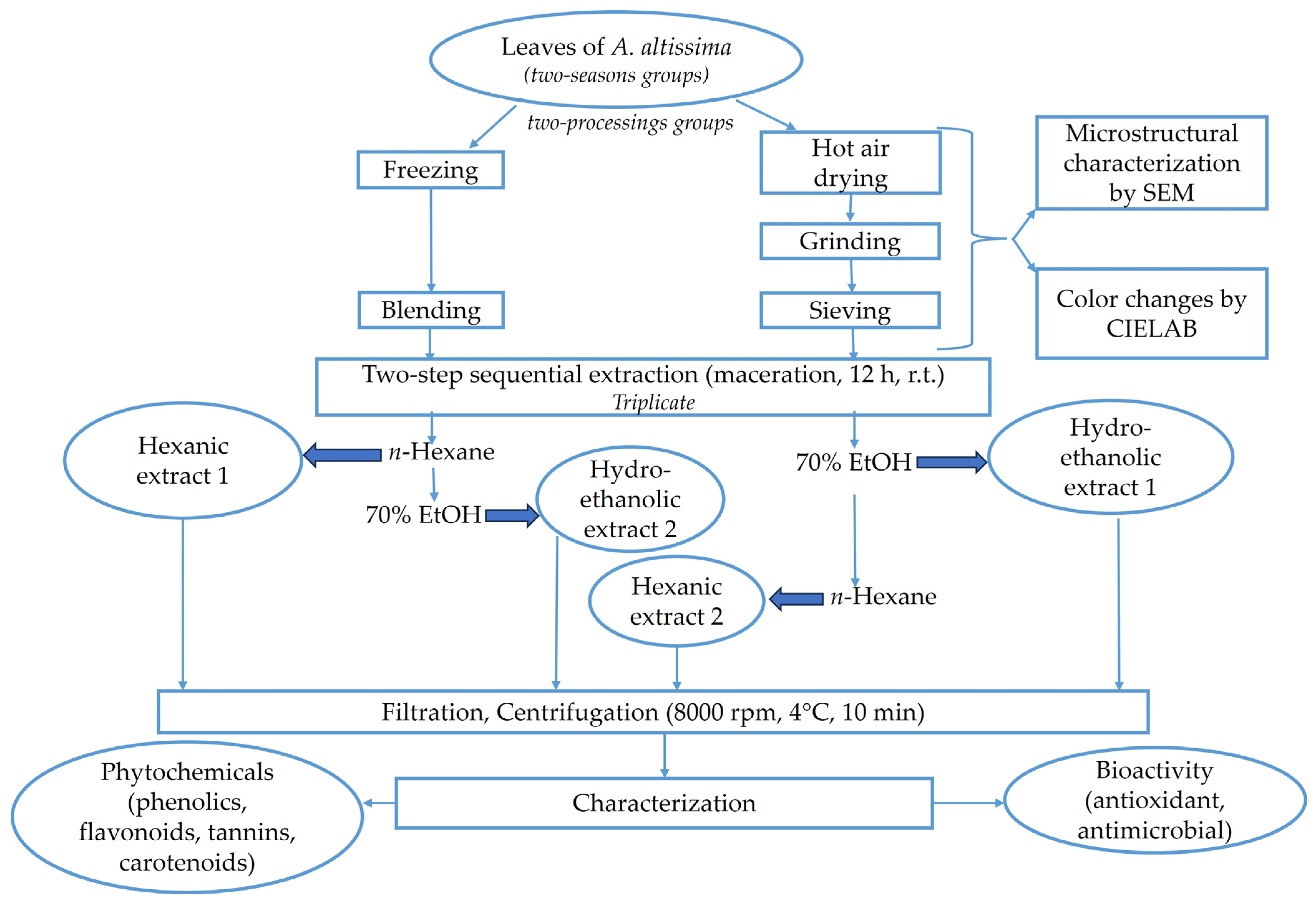
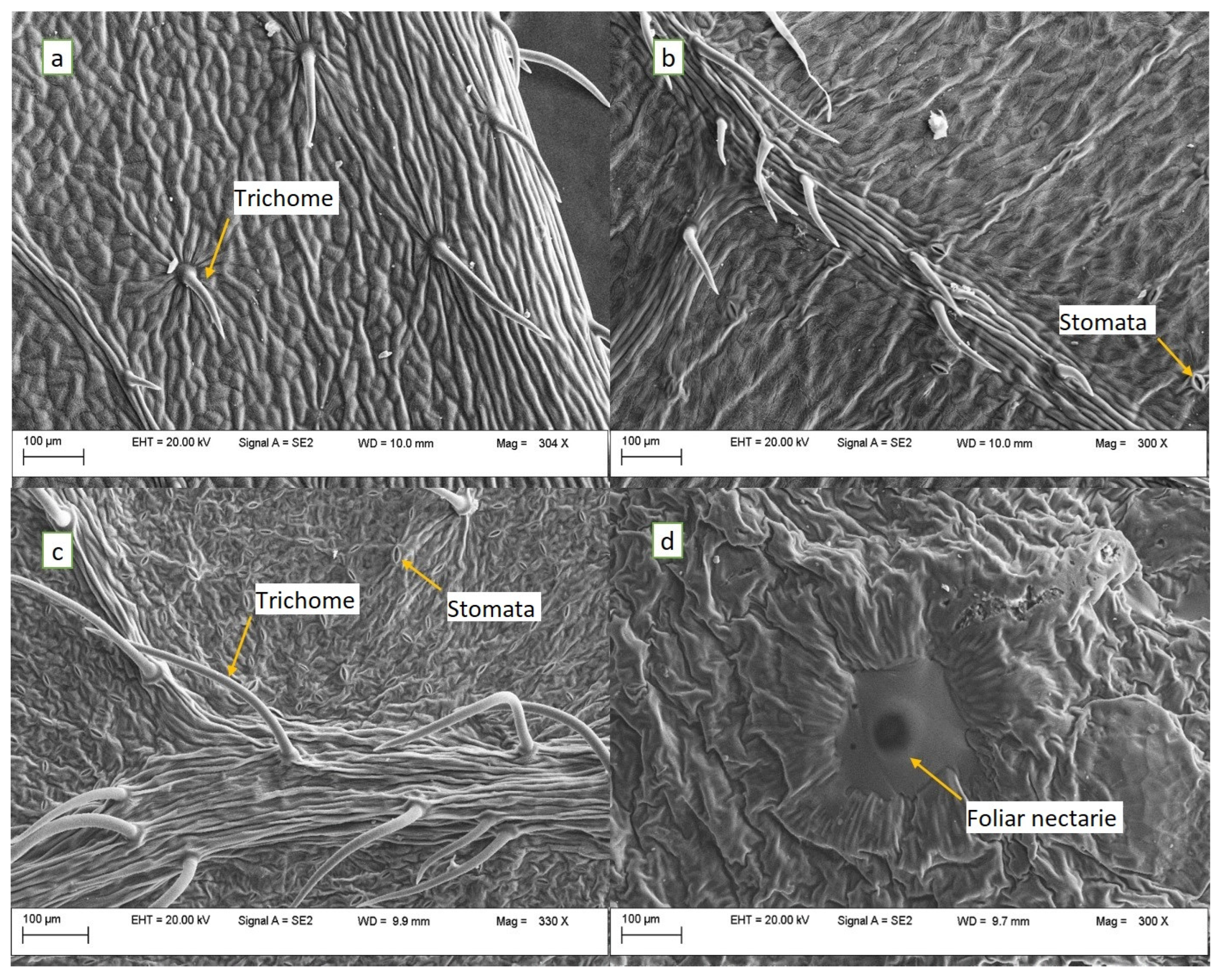
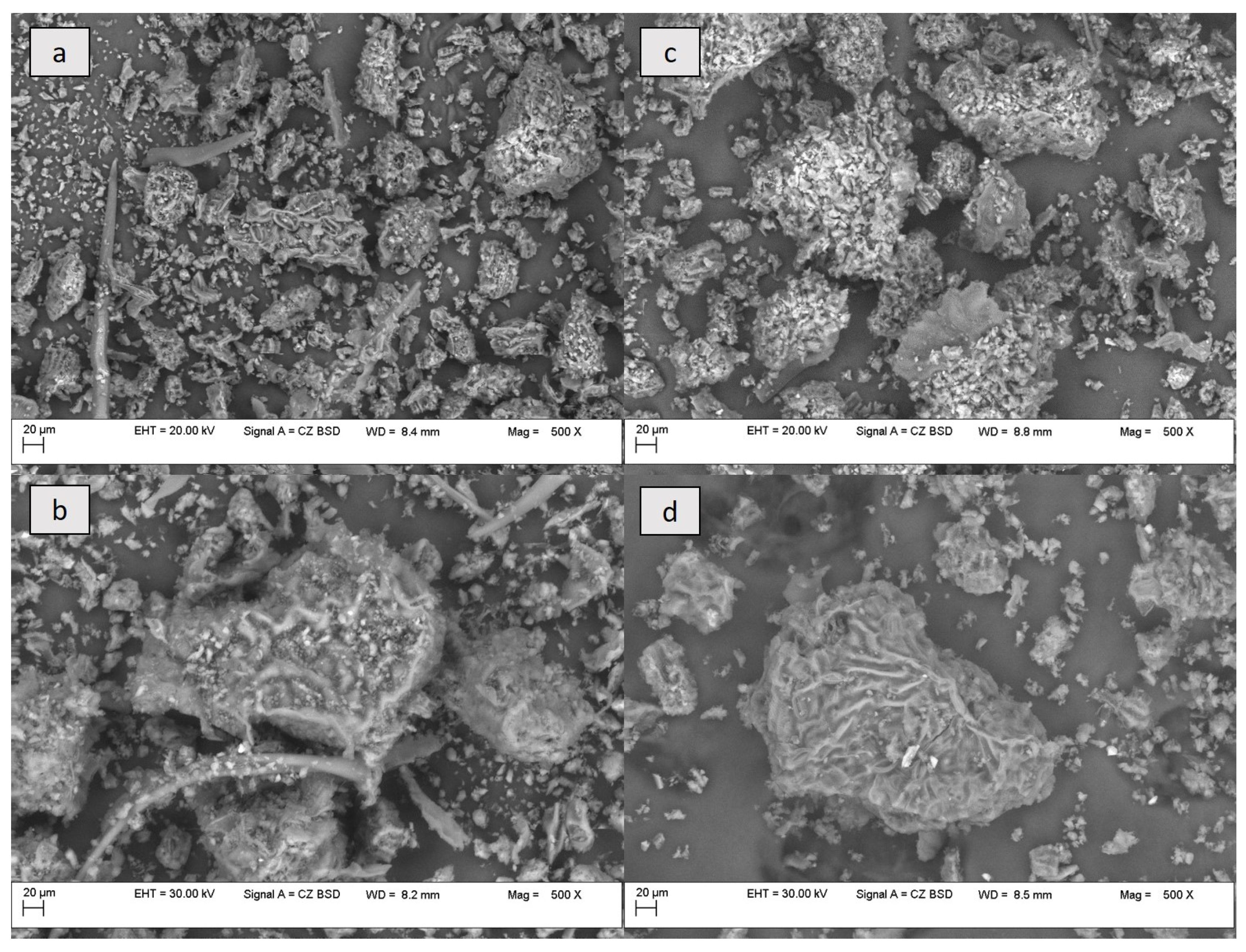


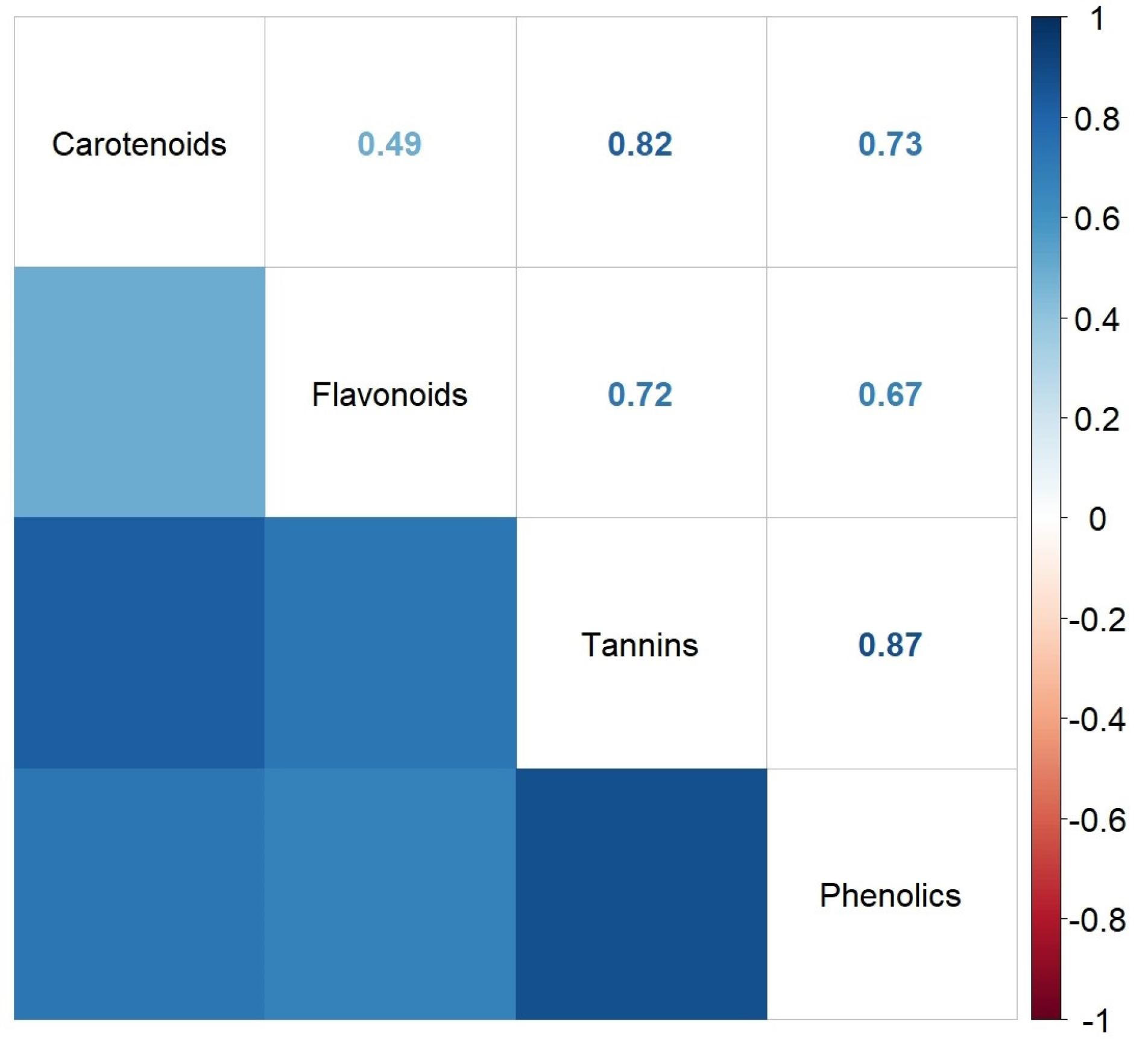

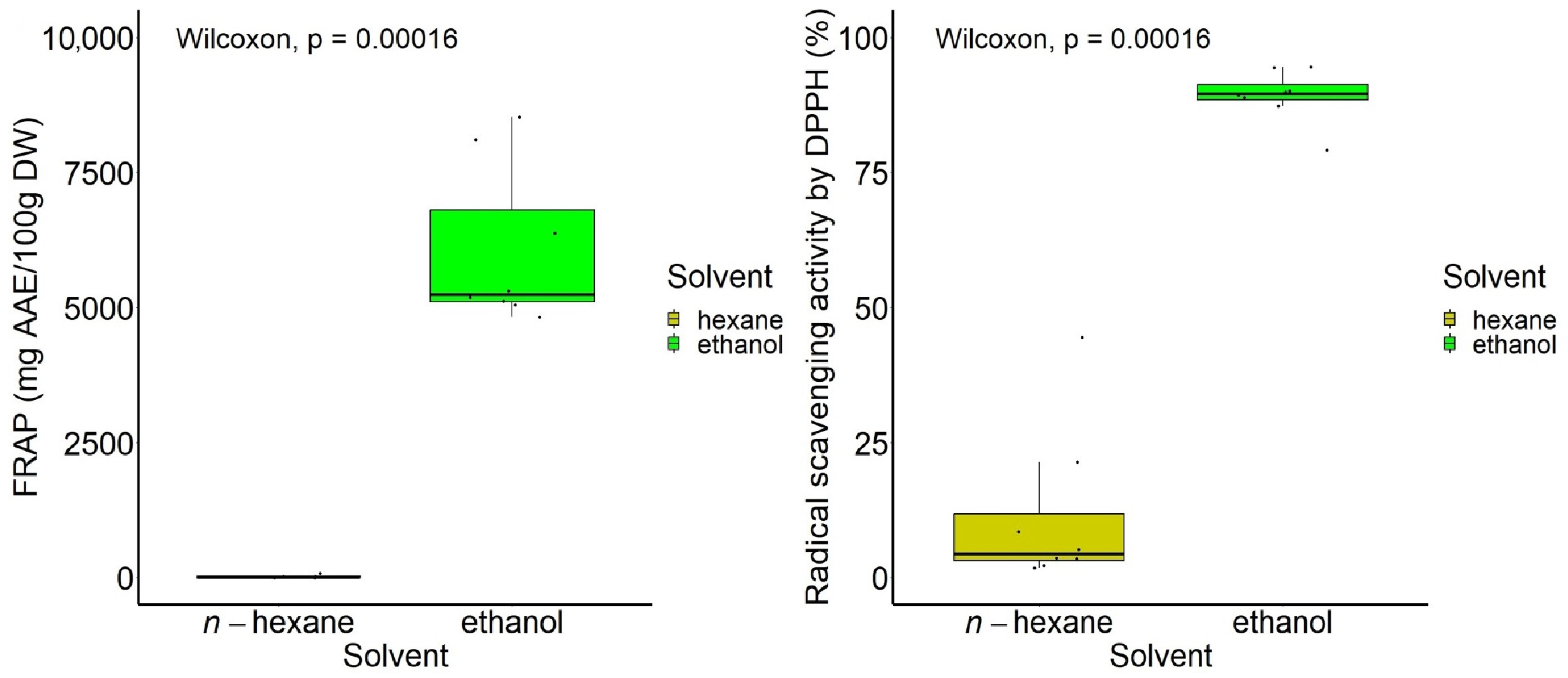
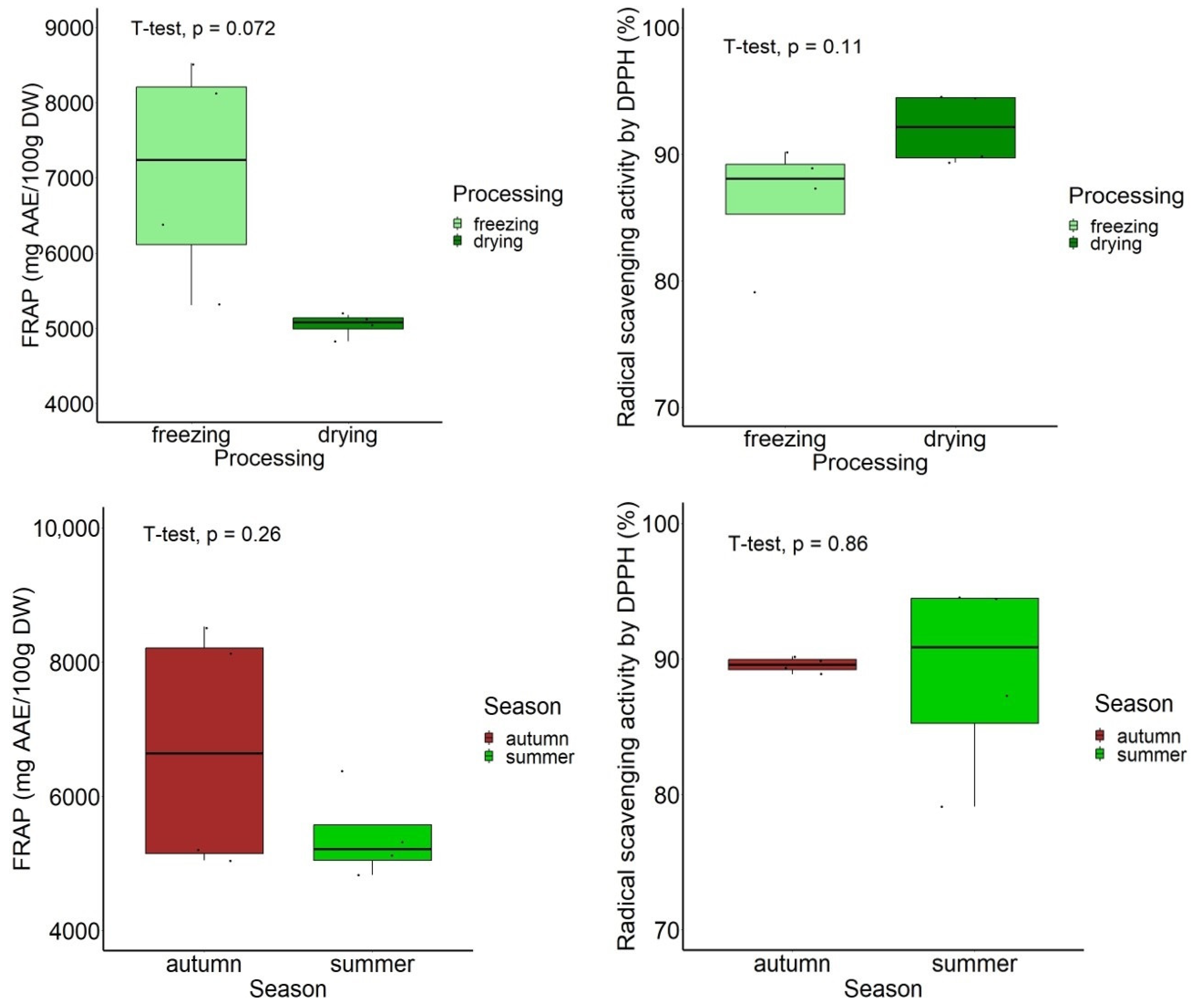
| Sample | Material Processing | L* | a* | b* | ΔE | Whiteness Index | Yellowness Index |
|---|---|---|---|---|---|---|---|
| A. altissima leaf acetone extract | 2° field of view | ||||||
| Freezing | 27.68 ± 0.82 | −43.90 ± 0.05 | 44.01 ± 0.07 | - | −14.81 | 96.01 | |
| Drying (r.t.) | 0.65 ± 0.11 | 0.46 ± 0.04 | 0.83 ± 0.16 | 67.54 | −0.14 | 74.19 | |
| Drying (30 °C) | 1.26 ± 0.05 | −0.58 ± 0.07 | 1.80 ± 0.04 | 66.00 | −0.32 | 83.86 | |
| Drying (50 °C) | 0.38 ± 0.05 | 0.09 ± 0.04 | 0.41 ± 0.05 | 67.68 | −0.06 | 63.04 | |
| 10° field of view | |||||||
| Freezing | 26.63 ± 2.66 | −35.05 ± 1.46 | 43.32 ± 2.83 | - | −14.81 | 96.01 | |
| Drying (r.t.) | 0.60 ± 0.10 | 0.42 ± 0.06 | 0.73 ± 0.13 | 61.23 | −0.14 | 74.19 | |
| Drying (30 °C) | 1.16 ± 0.28 | −0.40 ± 0.05 | 1.63 ± 0.42 | 59.90 | −0.32 | 83.86 | |
| Drying (50 °C) | 0.36 ± 0.17 | 0.15 ± 0.06 | 0.36 ± 0.07 | 61.44 | −0.06 | 63.04 | |
| Sample | Polyphenols as Individual Run | Polyphenols in Mixture Run | Frozen (Summer) | Frozen (Autumn) | Dried (Summer) | Dried (Autumn) | |
|---|---|---|---|---|---|---|---|
| Polyphenols | RT (min) | ||||||
| Gallic acid | 10.97 | 10.84 | 10.73 | 10.97 | 10.71 | 10.71 | |
| Protocatechuic acid | 13.98 | 13.90 | - | 14.04 | 13.97 | 13.99 | |
| Catechin | 15.63 | 15.91 | - | - | - | 15.79 | |
| Vanillic acid | 16.74 | overlapped with epicatechin | 16.64 | 16.79 | 16.6 | 16.65 | |
| Epicatechin | 17.28 | 17.38 | - | - | 17.34 | - | |
| Caffeic acid | 17.49 | 17.96 | - | - | - | - | |
| Syringic acid | 18.09 | overlapped with caffeic acid | - | - | - | - | |
| Rutin | 20.42 | 20.63 | 20.68 | - | 20.66 | 20.70 | |
| Ferulic acid | 22.38 | 22.35 | 22.12 | 22.32 | - | - | |
| p-Coumaric acid | 23.10 | 23.46 | 23.42 | 23.61 | 23.49 | 23.48 | |
| Hesperidin | 24.01 | 24.03 | 24.32 | - | 24.36 | 24.38 | |
| Rosmarinic acid | 26.33 | 26.69 | 26.46 | - | 26.57 | 26.53 | |
| Salicylic acid | 29.31 | 29.61 | - | - | - | - | |
| Quercetin | 34.72 | 34.65 | - | - | 35.07 | 35.22 | |
| Kaempferol | 39.71 | 41.00 | - | - | - | - | |
| Sample | Zone of Inhibition (mm) | ||||
|---|---|---|---|---|---|
| Microbial Strain | Frozen (Summer) | Frozen (Autumn) | Dried (Summer) | Dried (Autumn) | |
| Staphylococcus aureus ATCC 25923 | - | - | 8.0 ± 0.1 | 8.0 ± 0.1 | |
| Staphylococcus aureus clinical isolate | 8.0 ± 0.1 | 8.0 ± 0.1 | 10.0 ± 0.2 | 10.0 ± 0.2 | |
| Streptococcus pyogenes ATCC 19615 | - | - | - | 8.0 ± 0.1 | |
| Enterococcus faecalis ATCC 29212 | 8.0 ± 0.1 | 9.0 ± 0.2 | 9.0 ± 0.2 | 10.0 ± 0.3 | |
| Bacillus subtilis ATCC 6633 | - | - | - | 8.0 ± 0.1 | |
| Salmonella enterica ATCC 13076 | - | - | - | - | |
| Pseudomonas aeruginosa ATCC 27853 | - | - | - | - | |
| Escherichia coli ATCC 25922 | 9.0 ± 0.2 | - | - | 10.0 ± 0.2 | |
| Enterobacter aerogenes ATCC13084 | - | - | - | - | |
| Candida albicans ATCC 10231 | - | - | - | - | |
| Reference Strain | Antibiotic | Zone of Inhibition (mm) |
|---|---|---|
| Staphylococcus aureus ATCC 25923 | Gentamicin 10 μg/disc | 19–27 |
| Vancomycin 30 μg/disc | 17–21 | |
| Streptococcus spp. Beta-haemolitic group | Penicillin 10 μg/disc | ≥24 |
| Vancomycin 30 μg/disc | ≥17 | |
| Enterococcus faecalis ATCC 29212 | Gentamicin 30 μg/disc | 12–18 |
| Vancomycin 5 μg/disc | 10–16 | |
| Pseudomonas aeruginosa ATCC 27853 | Ciprofloxacin 5 μg/disc | 25–33 |
| Gentamicin 10 μg/disc | 17–23 | |
| Escherichia coli ATCC 25922 | Ampicillin 10 μg/disc | 15–22 |
| Gentamicin 10 μg/disc | 19–26 |
Disclaimer/Publisher’s Note: The statements, opinions and data contained in all publications are solely those of the individual author(s) and contributor(s) and not of MDPI and/or the editor(s). MDPI and/or the editor(s) disclaim responsibility for any injury to people or property resulting from any ideas, methods, instructions or products referred to in the content. |
© 2024 by the authors. Licensee MDPI, Basel, Switzerland. This article is an open access article distributed under the terms and conditions of the Creative Commons Attribution (CC BY) license (https://creativecommons.org/licenses/by/4.0/).
Share and Cite
Cocîrlea, M.D.; Soare, A.; Petrovici, A.R.; Silion, M.; Călin, T.; Oancea, S. Phenolic Composition and Bioactivities of Invasive Ailanthus altissima (Mill.) Swingle Leaf Extracts Obtained by Two-Step Sequential Extraction. Antioxidants 2024, 13, 824. https://doi.org/10.3390/antiox13070824
Cocîrlea MD, Soare A, Petrovici AR, Silion M, Călin T, Oancea S. Phenolic Composition and Bioactivities of Invasive Ailanthus altissima (Mill.) Swingle Leaf Extracts Obtained by Two-Step Sequential Extraction. Antioxidants. 2024; 13(7):824. https://doi.org/10.3390/antiox13070824
Chicago/Turabian StyleCocîrlea, Maria Denisa, Amalia Soare, Anca Roxana Petrovici, Mihaela Silion, Teodora Călin, and Simona Oancea. 2024. "Phenolic Composition and Bioactivities of Invasive Ailanthus altissima (Mill.) Swingle Leaf Extracts Obtained by Two-Step Sequential Extraction" Antioxidants 13, no. 7: 824. https://doi.org/10.3390/antiox13070824
APA StyleCocîrlea, M. D., Soare, A., Petrovici, A. R., Silion, M., Călin, T., & Oancea, S. (2024). Phenolic Composition and Bioactivities of Invasive Ailanthus altissima (Mill.) Swingle Leaf Extracts Obtained by Two-Step Sequential Extraction. Antioxidants, 13(7), 824. https://doi.org/10.3390/antiox13070824









